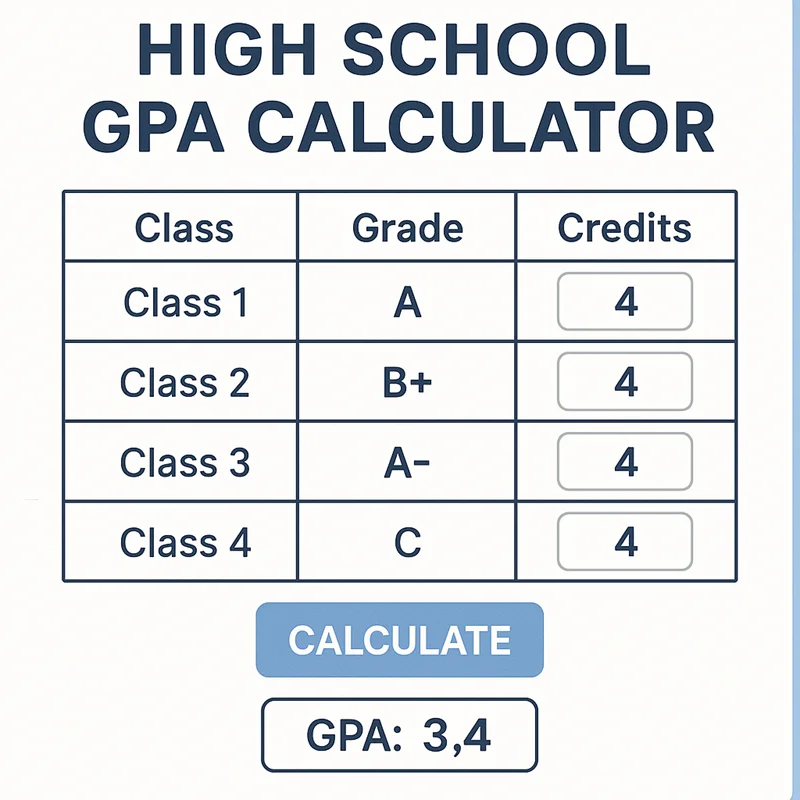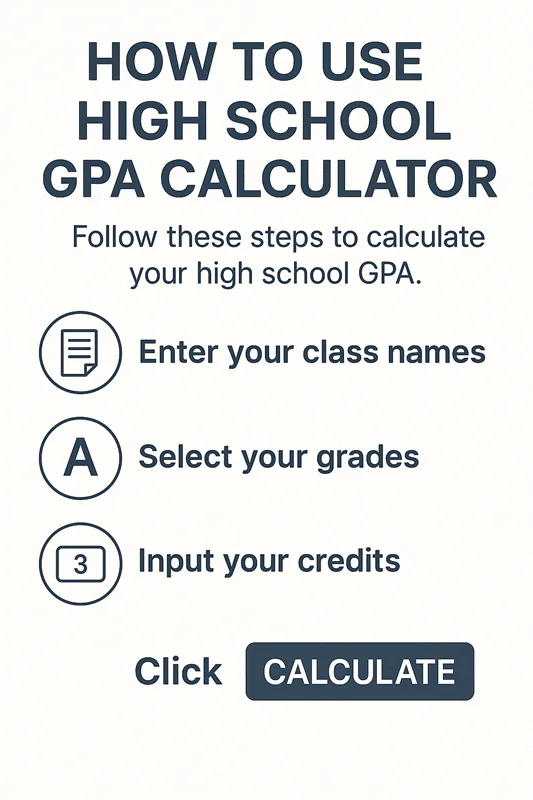Calculate your High School Grade Point Average
No courses added yet. Add your first course above!
| Letter Grade | GPA Points (4.0 Scale) |
| A | 4.0 |
| B | 3.0 |
| C | 2.0 |
| D | 1.0 |
| F | 0.0 |
| GPA Scale | A Grade | B Grade | C Grade | D Grade | F Grade |
|---|---|---|---|---|---|
| 4.0 Scale | 4.0 | 3.0 | 2.0 | 1.0 | 0.0 |
| 5.0 Scale | 5.0 | 4.0 | 3.0 | 2.0 | 0.0 |
| 100 Scale | 95–100 | 85–94 | 75–84 | 65–74 | Below 65 |

Understanding the difference between weighted and unweighted GPA is crucial for high school students.
An unweighted GPA treats all courses equally, regardless of difficulty. Every A is worth 4.0 points, whether it’s from PE or AP Physics. This GPA caps at 4.0.
Example: If you earn all A’s in regular classes, your unweighted GPA is 4.0.
A weighted GPA gives extra points for challenging courses like AP, IB, or Honors classes. These courses typically add 0.5 to 1.0 extra points to your grade.
Common Weighted Point Systems:
Example: An A in AP Biology might be worth 5.0 points instead of 4.0, boosting your overall GPA above 4.0.
Most colleges recalculate your GPA using their own system, so they’ll see both versions. However, weighted GPA better shows your willingness to take challenging courses.
Your GPA impacts many aspects of your academic and professional future:
Colleges use GPA as a primary factor in admission decisions. Higher GPAs open doors to more selective schools and competitive programs. Most four-year colleges expect a minimum 2.0 GPA, while top universities often require 3.5 or higher.
Many scholarships have GPA requirements. Merit-based scholarships often require GPAs of 3.0 or higher, with full-ride scholarships typically needing 3.5+. A strong GPA can save you thousands in college costs.
Honors programs, advanced courses, and special academic opportunities often have GPA thresholds. Maintaining a high GPA keeps these doors open throughout high school.
Your GPA reflects your work habits, consistency, and academic skills – qualities that matter in college and careers. It’s a foundation for lifelong learning success.
Ready to boost your grade point average? Here are proven strategies that work:
Your future grades have more impact than dwelling on past ones. Put maximum effort into current assignments, tests, and projects.
If your school offers weighted grades, consider taking AP, IB, or Honors courses in subjects you enjoy or excel in. The extra GPA points can significantly boost your overall average.
Don’t hesitate to ask for help when you’re struggling. Teachers appreciate students who take initiative, and they often provide extra credit opportunities or test retakes.
Use a planner or digital calendar to track assignments, tests, and project deadlines. Missing assignments can quickly damage your GPA.
Some schools offer credit recovery programs, summer school, or retake opportunities for failed courses. These can help repair GPA damage from difficult semesters.

A good GPA depends on your goals, but here's a general breakdown:
Yes, but the impact depends on how many credits you've already earned. Senior year grades matter less for GPA calculation if you have many previous credits, but colleges still see these grades on your transcript.
Focus on both. Unweighted GPA shows your overall performance, while weighted GPA demonstrates your willingness to challenge yourself. Colleges value students who take rigorous courses and perform well.
Most schools use this conversion:
However, schools may use different scales, so check with your counselor for your school's specific conversion chart.
Many colleges recalculate GPAs using their own methods. They might exclude certain courses (like PE), use only core academic subjects, or apply their own weighting system. This ensures fair comparison between students from different high schools.
Check your GPA at least once per semester to track your progress. Many students find it helpful to calculate after each grading period to see how individual courses impact their overall average.
Check your GPA at least once per semester to track your progress. Many students find it helpful to calculate after each grading period to see how individual courses impact their overall average.
Want more academic planning resources? Check out these helpful calculators:
Your high school GPA is a powerful tool for achieving your academic goals. Use this calculator regularly to stay on track, and remember that every grade counts toward your future success. Whether you’re aiming for a top university or planning your next academic steps, understanding and monitoring your GPA puts you in control of your educational journey.